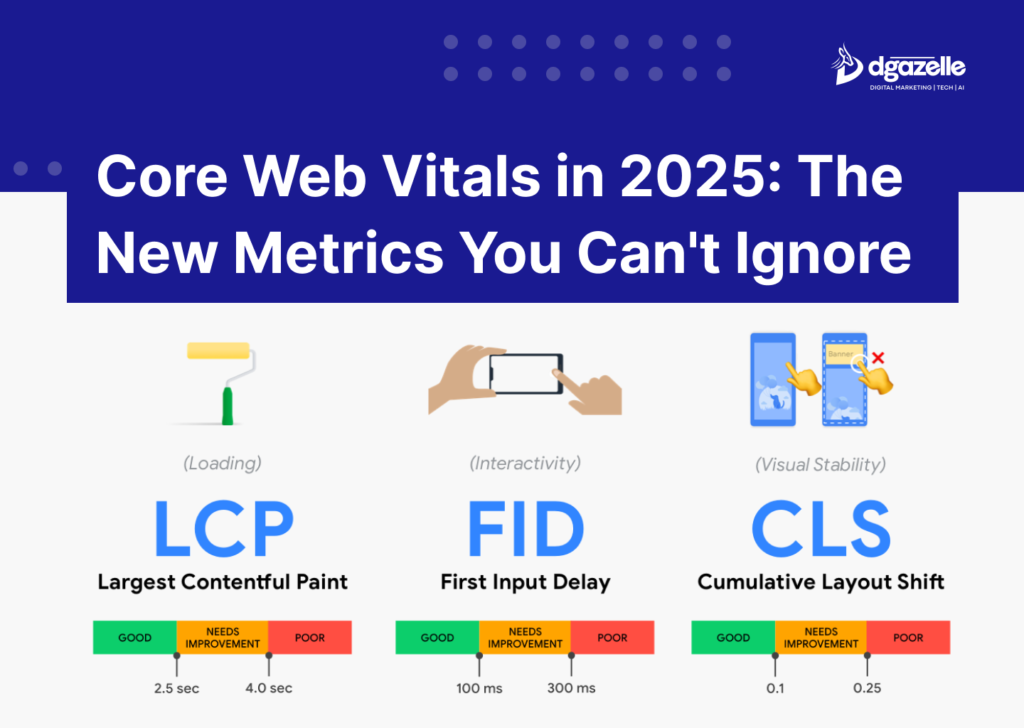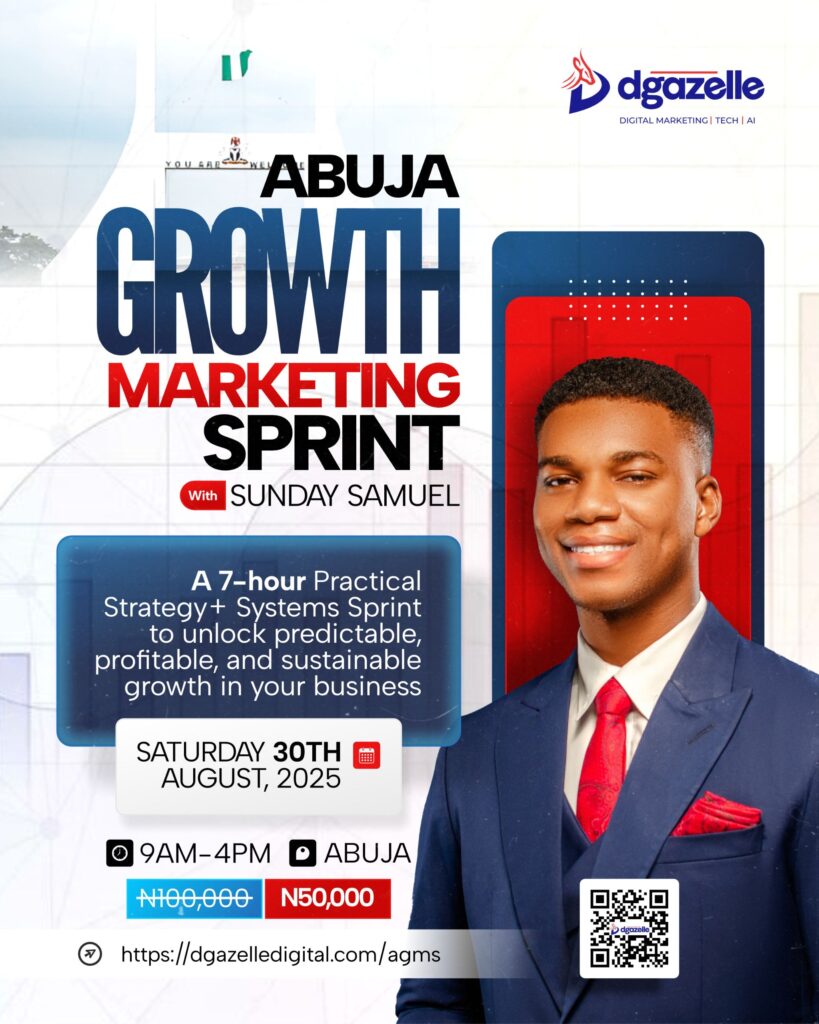We live in a world, where every second counts and so is it on your website too. Your site’s speed, stability, and responsiveness are more than technical details—they define the quality of your visitors’ experience. For small businesses in Nigeria, where competition is fierce, getting this right is critical.
Google’s Core Web Vitals focus on three key aspects: Loading Speed, Layout Stability, and Responsiveness. These metrics have become essential benchmarks for ranking and user satisfaction. Optimizing for Core Web Vitals in 2025 isn’t just about staying competitive; it’s about thriving online.
While we often prioritize keywords, mobile optimization, and backlinks, Google emphasizes on-page experience. Core Web Vitals measure how well your site loads, responds to actions, and maintains visual stability.
This guide simplifies these evolving metrics and highlights their impact on small business rankings. Learn how to deliver a stellar user experience and keep your site ahead of the competition.
What Are Core Web Vitals?
Core Web Vitals are Google’s way of measuring a website’s user experience across three critical areas:
- Largest Contentful Paint (LCP): This gauges loading performance—how quickly the main content on your page becomes visible. Google recommends it happens within 2.5 seconds. Delays often arise from unoptimized third-party scripts or media not loading asynchronously.
- Interaction to Next Paint (INP): INP evaluates your website’s responsiveness to user interactions, such as clicking a button or scrolling. Replacing the older First Input Delay (FID) metric in 2024, INP provides a better picture of overall responsiveness.
- Cumulative Layout Shift (CLS): This metric measures visual stability. For example, pages where images or fonts load improperly, causing layout shifts, frustrate users. Aim for a score below 0.1 to keep visitors happy.
These metrics aren’t just numbers—they shape user perception and influence how long they stay on your site, directly impacting conversions.
Why Should Small Businesses Care About Core Web Vitals?
Better SEO Rankings
Google uses Core Web Vitals as a ranking factor, giving small businesses a chance to compete against larger brands without a massive marketing budget. A poor performance on these metrics not only drops your ranking but can also make your website seem less credible.
Happier Customers
No one enjoys visiting a slow or glitchy website. Optimized websites that load quickly, respond instantly, and remain stable create a seamless, enjoyable user experience. Happy customers are more likely to trust your business and return.
Higher Conversions
Fast websites are proven to boost conversion rates. For small businesses, even slight improvements can translate into significant growth.
By prioritizing Core Web Vitals, small businesses can improve SEO rankings, enhance customer satisfaction, and ultimately drive more revenue—all while keeping user experience at the forefront.
The 3 Core Web Vitals
1. Largest Contentful Paint (LCP)?
Largest Contentful Paint (LCP) measures the speed at which your page’s primary content becomes visible to users. It reflects how fast the largest on-screen element, like a headline or hero image, loads, signaling your page is ready for interaction. What Contributes to LCP are:
- Header images or sliders rendered as
<img>tags - Background images
- Large text blocks (e.g., H1 headings)
Why is LCP Important?
A slow LCP frustrates users and drives them to competitors. Fast-loading pages improve user satisfaction, boost conversions, and enhance Google rankings. LCP Score cane be:
- Poor: > 4.0 seconds
- Good: ≤ 2.5 seconds
- Needs Improvement: 2.5–4.0 seconds
Use PageSpeed Insights to identify LCP bottlenecks and ensure your site delivers a fast, seamless experience. Prioritizing LCP isn’t just technical—it’s a competitive edge.
2. Interaction to Next Paint (INP)
Interaction to Next Paint (INP) gauges how quickly a webpage responds to user actions like clicks, taps, or keypresses. It tracks the longest delay during interactions, showing the site’s responsiveness in real-world use.
How Does INP Work?
- INP records delays from interactions and focuses on the longest within a session.
- For highly interactive pages, it excludes the single worst delay per 50 interactions, ensuring fairness.
- The 75th percentile of all interaction delays reflects the typical user experience.
Why is INP Important?
Introduced in March 2024 as a Core Web Vital, INP offers a broader view of site responsiveness than its predecessor, First Input Delay (FID). Optimizing INP ensures smooth interactions, boosting user satisfaction and Google rankings. An INP Score ranges from:
- Poor: > 500ms
- Good: ≤ 200ms
- Needs Improvement: 200–500ms
3. Cumulative Layout Shift (CLS)?
Cumulative Layout Shift (CLS) measures unexpected content movements during page loading, reflecting the visual stability of a site. Common Causes of CLS
- Images without defined dimensions.
- Ads, embeds, or iframes with undefined sizes.
- Dynamically injected content.
- Delayed font or style application.
Why is CLS Important?
A stable layout ensures a frustration-free experience, especially on e-commerce sites, where sudden shifts can disrupt clicks, purchases, and user trust. A strong CLS score improves usability and customer retention. Google recommends a CLS score of ≤ 0.1 for a stable experience. Scores are calculated by combining:
- Screen area affected by shifts.
- Distance elements moved.
How to Improve Core Web Vitals
Improving Core Web Vitals is crucial for enhancing your site’s user experience and SEO rankings. Here’s how to optimize each metric:
Largest Contentful Paint (LCP)
- Prioritize Critical Content: Reduce the content above the fold to show essential elements quickly.
- Optimize Images: Compress images, use modern formats like WebP, and remove large, unnecessary files.
- Enable Lazy Loading: Load images and videos only when they appear on the screen.
- Upgrade Hosting: Use a faster web host or Content Delivery Network (CDN).
Interaction to Next Paint (INP)
- Reduce Third-Party Code: Minimize external scripts to reduce delays.
- Streamline JavaScript: Remove unused code and focus on what users need.
- Minimize Main Thread Work: Simplify styles and layouts to reduce processing time.
- Optimize Requests: Keep requests minimal and file sizes small.
Cumulative Layout Shift (CLS)
- Set Media Dimensions: Always define width and height for images and videos.
- Reserve Space for Ads: Allocate fixed spaces for dynamic content to prevent shifting.
- Use Consistent Fonts: Ensure fonts load efficiently to avoid layout changes.
Regularly monitor progress with tools like PageSpeed Insights or Lighthouse for continuous improvements.
Conclusion
Core Web Vitals and SEO are intertwined, making them critical for outperforming competitors and maintaining strong rankings. Regardless of your industry, prioritizing Core Web Vitals enhances user experience and SEO performance, driving better engagement, conversions, and business success.
Transform your site with a design that scores high on Core Web Vitals and drives results. Let Dgazelle create a fast, responsive, and user-focused website for you today!







